If you like airplanes, driving into the pits early Monday morning is pure bliss. The sleek Formula One racers (minimum weight 500 lbs not including the pilot) are towed to the runway by golf carts. Crews sip hot coffee in the cold morning air and hope it heats up fast so the engines will run better. The Biplane racers come next looking almost like Disney characters they are so darn cute but don’t let their looks fool you. They tear around the course like oversized bumblebees at speeds of 250+ mph. Sport Class planes - the Ferraris of air racing - fill two giant hangars. A relatively new class, Sport has attracted a new generation of pilots. The warbirds are parked outside on the ramp. First up, the venerable T6 class. These ‘identical’ trainers demonstrate that pilot skills make a difference on the course. Among other things…Next up, the mighty warbirds; magnificent WWII fighters, row after row, including British Hawker Sea Furies, Russian Yaks, P-51 Mustangs, the Grumman cats, Wildcat, Bearcat, Tigercat, and an incredible Corsair that raced 50 years ago in Cleveland; twenty-seven planes plus three alternates. And finally, the L39 jets, two rows of metal sculpture - sky warriors that look fast standing still. The L39 Albatros is a Czechoslovakian-built attack trainer with a top speed approaching 500 mph. Although it was never used in combat, it was the front line trainer for many east-bloc countries during the Soviet military build up of the 70s and 80s. Now these gorgeous jets have found their way to the ramp to race at Reno. The pilots flying these planes will average over 400 mph, at 50 to 100 feet, on an eight-mile oval course with ten pylons. This is not your ‘$100 hamburger’ flying. You better be on top of your game to fly the ‘sticks’ at Reno. The pylons are actually telephone poles topped with bright red, orange or white drums so they stand out in the harsh desert terrain. Dedicated volunteer judges man each pylon to watch for low flying and pylon cuts. They look up through the drum to see if any part of the plane is visible. If they see anything, they call a cut and a costly time penalty is added to the pilot’s course time. Many a race has been determined after the finish by pylon cuts. To fly the jets, you need 1000 hours total pilot time plus an L39 jet rating. There are nine entries this year with experience levels from four class rookies to two class champions. The guys that own these jets fly them for fun. Stuart Fred, pilot and owner of Tejas Pistol-aeros and Bryan Holland, owner of Gringo Bandito, flew their CJ3 and CJ2 (Citation Jet) to the race to crew for their teams. Stuart heads the Bomasada Group, a Houston based real estate development company. For the races he loads his jet with racing supplies, even a tow bar, and heads west. How cool is that! My husband, Dave Morss, flies Stuart’s jet. Trevor Scheafer, an ex-F15 instructor pilot, flies Bryan’s jet. This is his first Reno. I agree with his wife, Robin, ‘Studs fly jets’. The L39 Jet Class is a match race with each plane essentially the same. Each jet must pass tech inspection before it can fly on the course. Each class of planes is assigned a time slot for practice and qualification. All the planes must post a qualifying time by noon on Wednesday. Not all of the jets have finished with tech inspection by the scheduled slot on Monday. At the morning pilot briefing, the group decides to do a practice start. This involves a take-off, then flying formation around Peavine Mountain and entering the course at the guide pylon. Dave heads right to the course, skipping the ‘start practice’. For him, the course time is more valuable. He films each race from the cockpit and critiques his line back in the hotel room at night. On Tuesday, Dave qualifies at 430.756 mph. That puts him third in the field. John Penney, 2005 Class Champion, qualifies at 468.788 mph to take the pole. By noon on Wednesday, the field is set and all nine racers have passed tech and qualified. One of the L39s is for sale. A buyer makes a deposit and they withdraw Race 68 from the race. Now there are eight racers. I time Dave’s races. It gives me something useful to do instead of worrying. I’ve got my timer board ready as they come down the chute for a demo race on Wednesday afternoon. It is so hot I can hardly breathe. At the start, Jets are going every which way. This is one of the worst starts I’ve ever seen. In just a few seconds, they sort themselves out and Dave flies a high line to stay out of the fray. A few of the pilots are on the deck. The low fly limit is 50 feet but the temptation to get down in the dust seems to call a few of our rookies lower. Sometimes mechanical turbulence can slow you down more than ground effect gives you speed. Since this is a demo race, Dave decides to make a show of it and cuts pylons four and five to come up behind John in front of the grandstands. Makes for a great photo opportunity. The pilots debrief after each race. Thankfully someone had a camera in the cockpit and captured the start so they get a chance to take a second look. Nobody got hurt so this was a good day for learning old lessons, the first being ‘Never break your contract with your wingman’. I get a little grayer after each race. I seek shelter in the motor home as the thermometer tops 97 degrees but this is Reno so one thing’s for sure. The weather is about to change.
dropped fifty degrees and the wind is howling. I feel sorry for the Formula One and Biplane racers. To fly in this kind of wind is not easy. They call off the race if the winds exceed 35 knots sustained. Everett Long, judge from Pylon 4, pays a visit. He wants to see the belly on Race 1. He says he never saw a cut like that. ‘He didn’t just miss the pylon, he missed the whole parking lot!’ I explained what Dave was doing and promised to email him a belly shot. The volunteers at Reno are an amazing bunch with fascinating stories of their own. They do this every year through hot and cold, rain and snow; the volunteers make the race possible. The one trait they all share is a love of aviation. Everett was the first American to fly a private airplane through the USSR, and wrote a book, ‘Cobras Over the Tundra’. There has been some criticism of the jet class that it is a parade rather than a race. Thursday’s race bears this out. Qualifying position is everything in air racing. It is very hard to pass and passing is generally done on the outside unless it can be done safely on a straightaway. The jets taxi out for the start.
the planes are lighter but there is always speculation. The heat finishes in the start order but they have to fight for their landings with the wind gusts to 47 knots. These guys are great pilots. After the race, Dave talks with Rick Vandam, who qualified second, and they decide to start from the back for Friday and Saturday’s races. This puts the second and third fastest jets in positions seven and eight. Racing is still a spectator sport and the crowd should see some exciting passes. John Penney has a different goal. He wants to beat the Unlimited Race Record. John’s says, ‘When you race L39s, the throttle has two positions; shame and glory’. This quiet, unassuming gentleman is the three-time Gold Champion in the Unlimited Class and current champion in Jets. He’s a pilot for United Airlines the rest of year. Yesterday I was making lemonade and today it’s hot chocolate. It’s so cold that I time and film from the motor home. Stuart and I spend an hour giving Bryan marketing advice on his new venture, selling a hot sauce he developed, Gringo Bandito. He gives us samples and this stuff is fabulous. Later, I find out he’s sold 32 million records so he probably doesn’t need any marketing help from me. I noticed that kids kept asking Bryan for his autograph so I finally asked Stuart what was going on? Turns out ‘Bryan’ is Dexter Holland, the founder and lead singer and guitarist of the band Offspring. I never heard of them but the last band I followed was Fleetwood Mac so don’t go by me. I Google him that night and discover that he flew his Citation Jet around the world in ten days - solo. Now that’s really impressive. He’s also a PHD candidate in molecular biology, so this is one smart guy. He took delivery of his jet at Reno and the first thing he did, race it. Very Cool. Friday starts out cold and gets colder. The crowd is sparse and even the US Air Force Thunderbird team draws a scant audience. But today the local schools visit on a field trip so we have lots of kids to talk to and answer questions about the racers. I hand out Tejas Pistol- aero tattoos. The kids go crazy. I make them promise to cheer for Race 1. The jets go again at noon. As planned, Dave and Rick start from the back. The starts are getting better and this time when they come down the chute, the formation is tight and intact. As the planes come around home pylon, the guys put on a great show. The middle of the pack fights it out for position. Dave is high and dives to pass Trevor but can’t make it stick. John pulls away from the field and finishes with a race speed of 466 mph. Dave passes Larry Teuber in Tornado and Cliff Magee, in Giantkiller and finishes 6th. Rick gets by all of them and Trevor in Gringo Bandito to take 4th. This race was no parade. But the stands are empty and we pray for better weather. Our prayers are answered. Saturday morning at Reno is beautiful, no wind and a forecast high of 75 degrees. Old and young alike walk around the pits with happy smiles and stars in their eyes as they get up close to these spectacular airplanes. Young boys shyly present their programs to the pilots for autographs. Old men smile and remember flights gone by. A father holds his daughter in his arms and points to the sky as one of the air show acts begins. Even the sounds at Reno are special. A Mustang starts on the ramp and the throaty Merlin engine roars to life. The F18 pilots shatter the stillness with an overhead pass. The Formula One planes zoom around the course. The Biplanes taxi out to the start position. The T6s warm up on the ramp. The vendors hawk their hot dogs and sodas. What a day. The Saturday Jet race starts at noon when the planes are towed to the ramp. The canopies sparkle in the bright sunlight, every inch polished to a diamond finish. The pilots and crew brief for a few moments before takeoff. The routine is the same with Rick and Dave starting from the back and John flying to beat those Unlimited records. The jets roar down the runway one after another and lift off into the clear blue sky. I listen to the radio on the pilot’s frequency as Jim O’Neal, the pace pilot, gets the group lined up and ready to start. As they come down the chute, he says, ‘Looking good everybody, nice formation. Gentlemen, you have a race’ I can tell even before they reach home pylon, they are going a lot faster today. The conditions are perfect. Once again, the guys put on a great exhibition of tight flying and great passing. Rick moves from 7th to 2nd passing everyone except John. John laps at least two planes and finishes with a speed of 484.602 mph. He’s getting closer to the record of 507 mph. Dave finishes 4th passing Cliff, Larry, Brad Morehouse in Race 4 and Trevor. I bet they’ll be talking about this race on the AAFO message boards. Back at the hotel, we are rewarded with great room service and spectacular video footage. As a bonus, Trevor gave me The Offspring’s Greatest Hits CD. We listen to the music while we eat dinner and find a piece that is perfect for a race video. We use muvee to create our race videos then Dave burns a copy to give to Bryan in the morning. Sometimes technology is wonderful beyond words. Not often but sometimes. Tomorrow is the big day. If you make it to Sunday, you can go home happy. This year, a lot of planes did not make it to Sunday. But the jets haven’t skipped a beat all week and they are all ready to race in Sunday’s finale. This time everyone starts in qualifying order, so Rick and Dave are back at second and third. The pace plane roars down the runway and just as it’s ready to rotate and lift off, he suddenly hits the brakes. The canopy has come off and pieces shatter all over the runway. The jets behind the pace have started to roll. The first three hit their brakes and turn off on the taxiway. The rest hold in position. Workers clear the runway of debris and the pace plane taxies back to the ramp. Next thing we know the jets are rolling again, this time without a pace plane. I have never seen this before; a race with no pace plane. John Penney takes over the responsibility and does a fine job of keeping the formation in order. The announcer tells us that the race has been cut to four laps because they used up so much fuel taxiing. They come down the chute in formation but this time it’s John’s voice we hear saying those special words, Gentlemen, you have a race.’ John leaps to the lead with Rick close on his tail. The rest of the jets fight it out in a tight race. Third, fourth and fifth have race speeds of 433, 432 and 431mph respectively. Dave finishes fourth. He’s disappointed he lost a position but that’s racing. John finishes first with a speed of 470. Considering his extra duty as pace plane, that’s pretty respectable. He’ll have to wait till next year to go after that elusive Unlimited record. At the awards banquet that evening, Dave’s already making plans for next year. He leans over and whispers in my ear, ‘Only 358 days till Reno, babe’. This band of stalwart heroes comes together once a year to tempt fate in the hopes of claiming that legendary prize, Reno Gold. The most thrilling and scary eight days a year – you’ve just got to come and see this! |

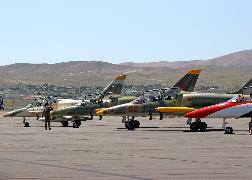
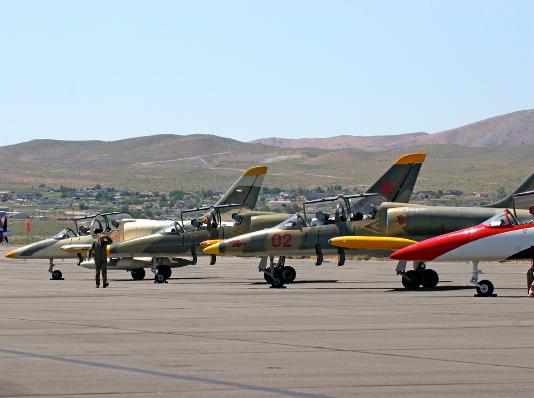
| L39s on the ramp before the race photo by Jeffrey Archer |
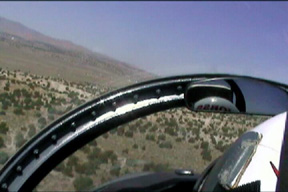
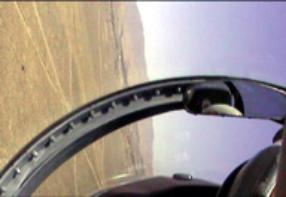
| Cockpit camera Take a ride on the course |
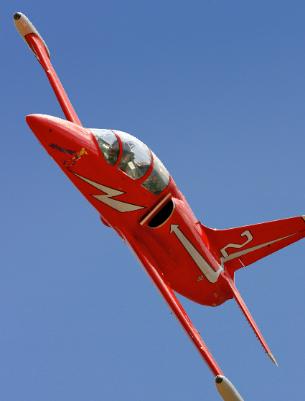
| Two time Jet Champion John Penney in Joe Gano's Pipsqueak, Race 2 photo by Victor Archer |
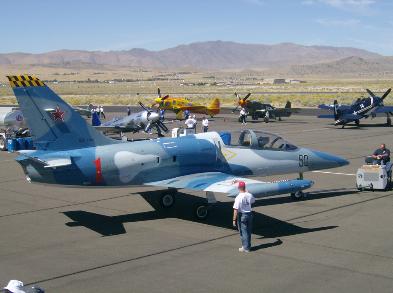
| The ramp at Reno |
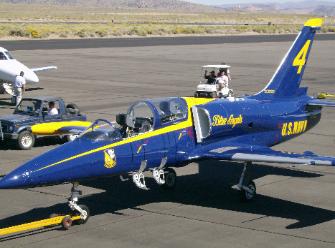
| Pace plane after losing canopy photo by Tim Silva |
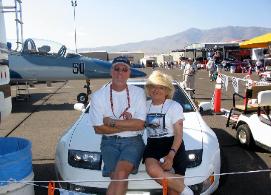
| Dave and Karen before the race |
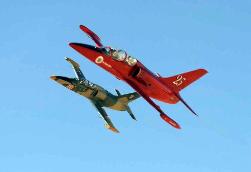
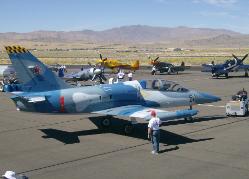
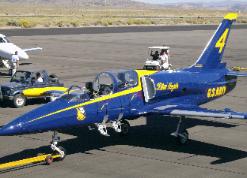
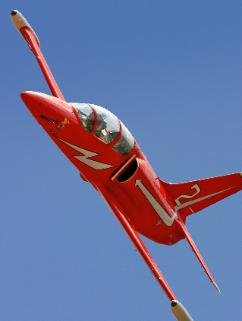
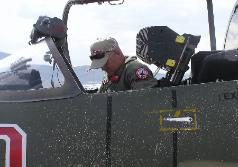
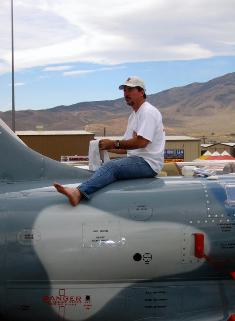
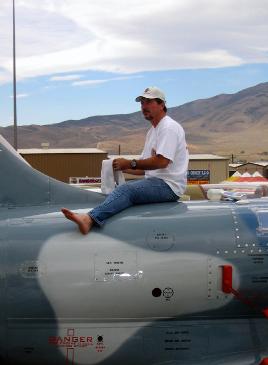
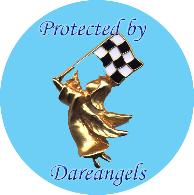
| Stuart Fred polishes Tejas-Pistolaeros photo by Karen Morss |
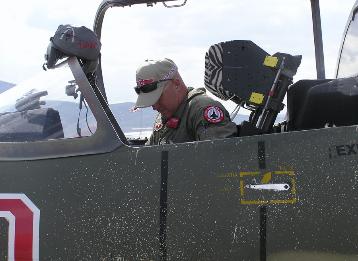
| Trevor Scheafer straps into Gringo Bandito |
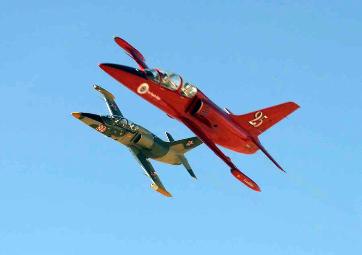
| photo by Jim Peterson |
| Racing |
